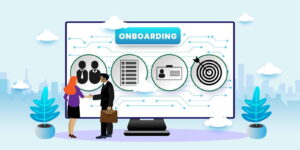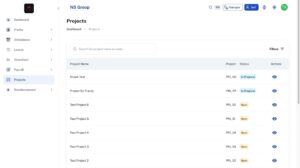A Guide to Digital Employee Onboarding


In today’s fast-paced digital landscape, successfully integrating new employees into your organization has never been more critical. Traditional onboarding methods, which often involved mountains of paperwork and face-to-face orientations, are swiftly being replaced by digital solutions.
These innovations not only streamline the onboarding process but also enhance the overall experience for new hires.
In fact, according to a report by the Work Institute, companies that excel in digital onboarding can expect to see a 50% increase in employee productivity. This staggering statistic highlights the tremendous opportunities at hand if digital onboarding is executed effectively.
However, transitioning to a digital onboarding system isn’t without its challenges.
Technical issues, data security, and the potential for impersonal interactions are just a few of the hurdles businesses must navigate.
Yet, the benefits — from increased efficiency to greater employee satisfaction — far outweigh the obstacles.
That’s why we’ve compiled this comprehensive guide to help you master the art of digital employee onboarding. We’ll cover essential steps, share valuable insights, and offer practical tips to ensure that your onboarding process is as seamless and effective as possible.
What Is Employee Onboarding Process?
The employee onboarding process refers to the structured series of events that help new hires acclimate to their roles and the organizational culture. This process typically begins when a candidate accepts an offer and can extend through their first year, though it’s most intensive during the initial weeks or months.
Effective onboarding accelerates the transition of new employees into contributing team members by providing them with the necessary tools, resources, and knowledge to succeed in their positions.
Moreover, it fosters a sense of belonging and alignment with the company’s values and objectives, significantly enhancing employee retention and job satisfaction.
Onboarding generally includes multiple phases, starting with pre-boarding tasks such as sending welcome emails, gathering necessary documentation, and setting up workspace and equipment.
This is followed by formal orientation sessions, during which employees are introduced to company policies, procedures, and key personnel.
Training programs are often integrated to develop specific job-related skills, and ongoing support is provided through mentorship and regular check-ins.
Digital Employee Onboarding Vs. Traditional Employee Onboarding
| Aspect | Digital Employee Onboarding | Traditional Employee Onboarding |
| Personalization | Tailors the onboarding experience to the new hire’s role and background using digital tools. | Limited personalization often follows a generic template for all new hires. |
| Efficiency | Automates repetitive tasks, significantly speeding up the onboarding process. | Typically, it involves lengthy paperwork and manual processes, making it time-consuming. |
| Accessibility | Accessible from anywhere, allowing remote and hybrid workers to onboard easily. | Limited to physical locations, restricting access for remote employees. |
| Cost Reduction | Reduces costs associated with printing, storage, and in-person training sessions. | Higher costs due to in-person training, materials, and administrative overhead. |
| Engagement | Utilizes interactive content and tools to enhance employee engagement. | Relies on in-person sessions, which may not engage all employees effectively. |
| Automation | Leverages software to streamline processes and reduce manual tasks. | It lacks automation and often requires significant manual input and oversight. |
| Consistency | Ensures a uniform onboarding experience across all new hires, regardless of location. | Varies by department or manager, which can lead to inconsistencies in the onboarding experience. |
| Face-to-Face Interaction | Limited opportunities for personal interaction, which may lead to feelings of isolation. | Provides ample opportunities for new hires to meet colleagues and build rapport. |
| Cultural Immersion | May struggle to convey company culture without in-person interactions. | Strong emphasis on cultural integration through in-person activities and introductions. |
| Mentorship | Often lacks immediate mentorship; relies on digital communication tools for support. | Typically assigns a mentor or buddy for hands-on guidance during the initial phase. |
| Feedback Mechanisms | Facilitates continuous feedback through digital platforms, allowing for real-time adjustments. | Feedback is often delayed and may occur only at scheduled intervals. |
| Compliance | Built-in compliance features help ensure all documentation is completed accurately. | Compliance relies on manual checks, which can lead to errors or omissions. |
Stages of Digital Employee Onboarding
Before The First Day (Preboarding)
The preboarding stage sets the tone for a new hire’s entire experience within the company. This phase occurs after the job offer is accepted but before the employee’s official start date.
It’s an important period that helps build excitement, reduces anxiety, and ensures the new employee feels welcomed and informed.
Vodafone has introduced its Digital Onboarding Platform, which new hires can access as soon as they sign their acceptance letter. This platform navigates them through the onboarding process by offering crucial company information and enhancing Vodafone’s overall onboarding experience.
Here’s how to make the most out of your digital preboarding stage:
Sending a Welcome Email
An effective Pre-Onboarding process often kicks off with a warm and welcoming email.
This email should not only include a heartfelt note of welcome but also provide crucial information about the company’s culture and values and what to expect during the onboarding journey.
Highlight the company’s mission, share a brief history, and outline the next steps in the onboarding process so the new hire feels informed and prepared.
Providing Access to an Online Portal
To facilitate a smooth integration, the new employee is provided access to an online portal where they can complete all necessary paperwork before their official start date.
This may include filling out tax forms, submitting direct deposit information, and reviewing company policies.
The convenience of an online portal ensures that the new hire can complete these tasks at their own pace, reducing stress on their first day and allowing them to hit the ground running.
Assigning a Mentor or Buddy
Assigning a mentor or buddy is another important component of the Pre-Onboarding phase.
This individual will serve as a guide, helping the new hire navigate their first days and weeks with the company. This relationship not only assists in practical matters, such as understanding company protocols and workflows, but also helps build a sense of belonging and community.
A buddy system fosters a supportive environment where questions are encouraged and guidance is readily available.
Sending a Personalized Video Message
A personalized video message from the team or manager can add a personal touch to the pre-onboarding stage. This video serves as a warm welcome, showcasing the faces and personalities of the people the new hire will be working with.
It’s a heartfelt gesture demonstrating the team’s excitement and eagerness to welcome the new member. This can be particularly impactful in a digital onboarding scenario, where face-to-face interactions are limited.
The First Day
The first day at a new job is a pivotal moment, filled with anticipation and nerves.
A thoroughly planned orientation can transform these mixed emotions into a productive and positive start.
The first day’s goal is to make the new employee feel welcomed, valued, and informed, ensuring a smooth transition into their new role.
Here’s how to structure an effective digital orientation:
Providing a Virtual Tour
Without physical walkthroughs, a well-designed virtual tour can offer a comprehensive view of the company and its facilities.
This tour should highlight key areas, such as virtual workspaces, common areas for team collaborations, and any important landmarks that contribute to the company’s unique environment.
By familiarizing the new hires with their digital surroundings, you help bridge the gap between the virtual and physical worlds, making them feel more integrated.
Conducting Online Orientation Sessions
Online orientation sessions serve as the cornerstone of Day 1 onboarding.
These sessions should encapsulate the company’s mission, vision, values, and culture, providing a holistic understanding of what the organization stands for.
Engaging presentations, interactive modules, and Q&A segments can make these sessions more dynamic and memorable. The goal is to align the new hire’s values and goals with the company’s, setting the stage for meaningful engagement and productivity.
Setting Up Necessary Accounts and Tools
Equipping the new employees with the tools and systems they need to succeed is paramount on Day 1.
This includes setting up email accounts, granting access to necessary software and platforms, and providing login credentials for internal systems.
A well-prepared IT checklist ensures that the new employee can dive right into their tasks without unnecessary delays. Providing clear instructions and support for these setups will minimize technical hiccups and allow the new hire to focus on their role.
Scheduling Virtual Meetings
Building connections with team members and key stakeholders fosters collaboration and camaraderie.
Scheduling virtual meetings on Day 1 can help the new hire put faces to names and understand everyone’s roles within the organization. Ice-breaker activities or casual introductory chats can make these initial interactions more relaxed and engaging.
These meetings lay the groundwork for future teamwork and create a sense of openness and accessibility.
First Week Onboarding
The first week of onboarding marks a pivotal phase in the new employee’s journey, transitioning from initial introductions to a deeper immersion into their role and responsibilities.
This period is integral for setting the pace and tone of the employee’s experience, ensuring they feel fully supported and equipped to succeed.
A multi-faceted approach is employed during this stage to balance learning, social integration, and consistent feedback.
Completing Online Training Modules
A comprehensive suite of online training modules and courses tailored to the employee’s specific job function is essential for skill acquisition and role clarity.
These modules should encompass technical skills, industry best practices, and role-specific procedures. Ensuring that the training is interactive and self-paced can enhance engagement and retention.
The aim is to provide a robust knowledge framework that empowers new hires to perform their job confidently and competently.
Participating in Virtual Team-Building Activities
Connecting with colleagues is key to building a cohesive and collaborative work environment.
Virtual team-building activities and social events are crucial in this integration process. These could range from ice-breaker games and virtual coffee breaks to more structured team challenges.
Creating opportunities for the new hire to interact with their team in a relaxed and fun setting helps build rapport and a sense of belonging. This camaraderie is fundamental for long-term collaboration and team synergy.
Receiving Regular Check-ins and Feedback
Regular check-ins and feedback sessions with the manager or mentor are vital during the first week.
These interactions allow the new employee to ask questions, express concerns, and receive constructive guidance. Scheduled touchpoints help ensure that the new hire is on the right track and aligned with their goals.
Constructive feedback not only facilitates growth but also builds a supportive relationship between the employee and their supervisor, fostering an environment of continuous improvement and open communication.
Accessing an Online Knowledge Base
An easily accessible online knowledge base or FAQ section is a valuable resource for ongoing reference and support.
This repository should include company policies, technical documentation, workflow guidelines, and other essential information.
With a centralized knowledge hub, the new hire can autonomously seek answers and clarification to common queries, promoting self-sufficiency and reducing dependency on immediate supervisors for routine information.
First Month of Onboarding
As the new employee navigates through their first month, the onboarding process shifts gears to emphasize long-term integration and continuous development.
This critical phase is designed to reinforce their initial experiences and pave the way for sustained growth within the organization.
Several key components form the cornerstone of this stage, ensuring the new hire remains engaged, motivated, and aligned with their career aspirations.
Ongoing Training and Development
Consistent access to training and development opportunities is essential in aligning the employee’s skills with organizational goals. Tailoring these opportunities to the individual’s needs and career aspirations is critical.
This could include advanced courses, webinars, certification programs, and soft and technical skills workshops. Providing a personalized learning path encourages the new hire to continually expand their expertise and remain agile in an evolving digital landscape.
This commitment to professional growth benefits the employee and enhances the organization’s overall talent pool.
Regular Performance Discussions
Frequent and structured performance discussions with the manager are pivotal to employee development.
These sessions provide a platform for open dialogue about their progress, challenges, and achievements. They are an opportunity to set clear expectations, identify areas for improvement, and discuss future objectives.
Regular feedback, whether positive reinforcement or constructive criticism, fosters a performance-driven culture and helps employees stay on track with their development goals.
This consistent alignment ensures that employees are aware of their contributions and are motivated to excel.
Contribution to Projects and Initiatives

Integrating the new employee into relevant projects and initiatives that align with their skills and interests is vital for practical experience and engagement.
These opportunities allow the new hire to apply their knowledge in real-world scenarios, fostering a hands-on learning environment. Encouraging participation in cross-functional teams and strategic initiatives enhances their understanding of the company’s operations and cultivates a sense of ownership and accountability.
This active contribution also provides visibility to their capabilities, paving the way for future career advancement opportunities.
Feedback Mechanisms
Gathering feedback about the onboarding experience through surveys or regular check-ins is essential for continuous improvement. Soliciting input from the new employee can uncover insights into what works well and identify areas that require adjustment.
This feedback loop fine-tunes the onboarding process for future hires and demonstrates a commitment to employee experience and well-being.
The organization can create a more effective and supportive onboarding framework by valuing and acting on this feedback.
Benefits of Digital Employee Onboarding
Organizations with strong onboarding processes see a 52% increase in employee retention and a 60% boost in productivity.
Additionally, 69% of employees with positive onboarding experiences will likely stay with the company for at least three years.
Here are some other benefits of digital employee onboarding:
Enhanced Efficiency and Consistency
Digital onboarding platforms automate many repetitive tasks associated with onboarding, such as completing paperwork, scheduling training, and disseminating vital information. This automation removes administrative burdens from HR personnel, allowing them to focus on more strategic initiatives.
Additionally, it ensures consistency in the onboarding experience, providing all new hires with the same high-quality, standardized introduction to the company’s policies, culture, and systems.
Organizations can maintain a cohesive onboarding process that uniformly supports every new employee by minimizing human error and variance.
Improved Employee Engagement and Retention
The initial experience a new hire has with an organization can significantly impact their level of engagement and overall satisfaction.
Digital onboarding facilitates a more engaging experience through interactive modules, virtual tours, and gamified learning environments. By making the process more dynamic and tailored to the individual, new employees are more likely to feel valued and connected to their new workplace.
This heightened sense of belonging and commitment can translate into higher retention rates, as employees are onboarded in a manner that fosters loyalty and motivation from the outset.
Accelerated Productivity
Employees who experience exceptional onboarding are 2.6 times more likely to be satisfied at work.
Furthermore, 89% of those with effective onboarding report high engagement levels.
Digital onboarding systems provide immediate access to essential resources, training materials, and learning modules, enabling new employees to quickly gain the knowledge and skills they need to perform their roles effectively.
This immediate immersion into the company’s operations reduces the time it takes for new hires to contribute meaningfully to projects and initiatives, thereby boosting the organization’s overall productivity.
Data-Driven Insights
One of the key advantages of digital onboarding is the ability to leverage data analytics to continually refine and improve the process.
Digital tools can track various metrics, such as time-to-productivity, training module completion rates, and new hire feedback. These insights help HR teams identify areas for improvement and measure the impact of various onboarding strategies.
Organizations can make data-driven decisions to continually optimize the onboarding experience by understanding what works and what doesn’t.
Scalability and Flexibility
Digital onboarding solutions are inherently scalable, making it easier for organizations to onboard multiple employees simultaneously, regardless of their physical location.
This especially benefits companies with geographically dispersed teams or those experiencing rapid growth. Moreover, digital platforms offer flexibility in tailoring the onboarding process to accommodate the unique needs of different roles, departments, or even individual learning preferences.
This adaptability ensures that the onboarding experience remains relevant and effective, regardless of the specific context.
Continuous Learning and Development
The benefits of digital onboarding extend beyond the initial integration phase. Many digital platforms offer ongoing learning and development modules that employees can access as they continue their journey within the organization.
This continuous learning approach supports career development and keeps employees engaged long after the traditional onboarding period has ended.
By fostering a continuous improvement and lifelong learning culture, organizations can ensure that their workforce remains agile and competitive in an ever-evolving business landscape.
You can also read our article on: Is Automated On-boarding a Boon or Bane?
4 thoughts on “A Guide to Digital Employee Onboarding”
Comments are closed.
You can create interest in any topic! Good job!
Spot on with this write-up, I really think this
amazing site needs a lot more attention. I’ll probably be
returning to read through more, thanks for the
info!